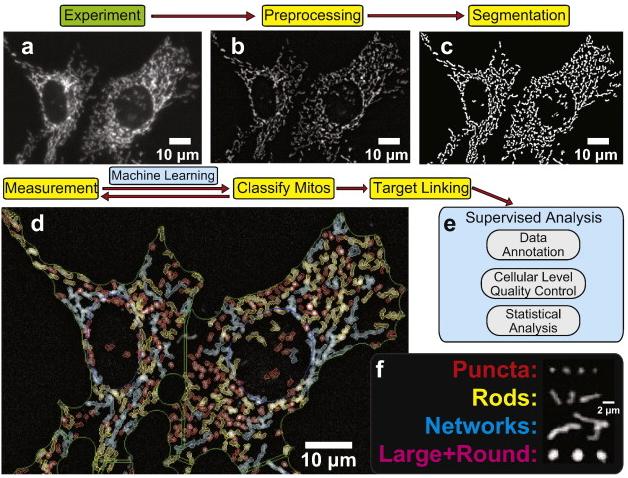Mitochondrial Phenotype Analysis using High-Content Imaging
Online InquiryMitochondria are highly dynamic organelles in the body responsible for generating the energy needed for the metabolism of the organism. The number of mitochondria and their distribution within the cell often change, which is inextricably linked to changes in mitochondrial morphology. Creative Proteomics offers mitochondrial morphology analysis services using high-content imaging. This method is well suited for the study of mitochondrial phenotype and structure. Confocal imaging and water immersion objectives can provide enhanced image quality and better representation of the mitochondrial structure, and high-content imaging analysis tools can help researchers obtain digital features of different phenotypes. Our service can be used to study mitochondrial dynamics in cell-based assays.
 Fig. 1 Overview of morphological binning-based analysis of mitochondrial morphology. (Leonard, Anthony P., et al, 2015)
Fig. 1 Overview of morphological binning-based analysis of mitochondrial morphology. (Leonard, Anthony P., et al, 2015)
Advantages of high-content imaging in mitochondrial phenotype analysis
- Enable in vivo imaging of cells cultured and processed in microtiter plates without washing steps to study cells in their most natural state in real time
- Obtain high-quality images that better reveal changes in mitochondrial shape and structure
- Quantify and measure phenotypic changes and distribution in mitochondria in a more efficient and accurate manner
- Promote mitochondrial dynamics-based cellular research
Mitochondrial phenotype analysis using high-content imaging
Here, our service is based on high-content imaging methods that enable large-scale mitochondrial measurements and the classification of mitochondria from thousands of cells based on interconnectivity and complexity in a single experiment. The development of deterministic fully automated algorithms improves throughput and allows the evaluation of entire cell populations in multiple replicate microscopic fields of repeated experiments, which in turn reduces observer and sampling bias.
The size and shape of mitochondria depend on their location within the cell and the energy requirements of different cells. When mitochondria are damaged, their morphology and integrity are altered, such as the number, size, length and shape of mitochondria. The determination of mitochondrial morphology and structure is important for understanding the homeostasis as well as the functional state of mitochondria.
Our services can help our clients with the following lists:
- Phenotypic analysis of mitochondria shape
- Mitochondrial dynamics
- Alterations in mitochondrial morphology and distribution
- Changes in mitochondrial membrane potential
Mitochondria are dynamic organelles that take part in the regulation of cell fate, homeostasis, survival and disease in eukaryotic cells. Mitochondrial phenotypes including morphology, dynamics, and organizational patterns differ significantly across cell types. Due to the importance of the mitochondrial phenotype in homeostasis, stress, and human disease, it is necessary to analyze and quantify changes in mitochondrial morphology and dynamic behavior. If you are interested in our mitochondrial phenotype analysis services, please don't hesitate to contact us. Our team of experts will be happy to provide you with knowledge and consulting services related to mitochondrial morphology analysis.
Reference
- Leonard, Anthony P., et al. "Quantitative analysis of mitochondrial morphology and membrane potential in living cells using high-content imaging, machine learning, and morphological binning." Biochimica et Biophysica Acta (BBA)-Molecular Cell Research 1853.2 (2015): 348-360.
* For Research Use Only. Not for use in diagnostic procedures.



